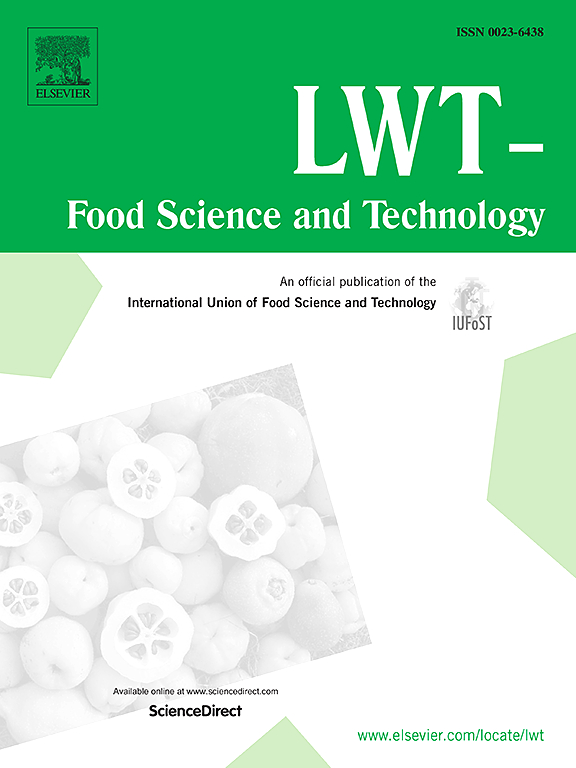Preparation, characterization and application of antimicrobial pectin-konjac glucomannan composite films incorporating cellulose nanocrystals stabilized clove essential oil pickering emulsion
IF 6
1区 农林科学
Q1 FOOD SCIENCE & TECHNOLOGY
引用次数: 0
Abstract
In this study, cellulose nanocrystals (CNCs) stabilized clove essential oil (CEO) Pickering emulsions (PE) were utilized to activate polysaccharide films based on pectin (PEC) and konjac glucomannan (KGM). Effects of emulsion dosage (0–15 wt%) on structural, physical and functional properties of the composite films were systematically investigated. Additionally, the application of film coating on grape preservation was explored. Results showed that CNCs stabilized CEO loaded PE (CCPE) exhibited an average size of 674.7 nm and demonstrated excellent physical stability. The results obtained from rheological and FTIR analyses suggest the potential existence of hydrogen bond interactions among the components of the film. SEM observation revealed the good dispersivity of CCPE within the PEC/KGM matrix at an appropriate amount. Overall, compared with control film, the incorporation of CCPE not only improved mechanical and water barrier properties, but also enhanced antimicrobial activities of the PEC/KGM films. Composite film containing 10 wt% CCPE was found to have a highest tensile strength of 23.58 MPa and a lowest water vapor permeability of 1.05 × 10−10 g/m·s·Pa, along with significant inhibition zone diameters of 38.77 mm and 29.03 mm respectively against S. aureus and E. coli. Notably, CCPE could further slow down the release rate of CEO from composite films as confirmed by the controlled release experiments. When applied to grape preservation, the film coating with 10 wt% CCPE was found to potentially delay postharvest grape senescence and maintain quality attributes during a 15-day storage period at 25 °C.

含有纤维素纳米晶稳定丁香精油萃取乳液的抗菌果胶-魔芋葡甘露聚糖复合膜的制备、表征及应用
本研究利用纤维素纳米晶(CNCs)稳定丁香精油皮克林乳剂(PE)活化以果胶(PEC)和魔芋葡甘露聚糖(KGM)为基础的多糖膜。系统研究了乳化液用量(0 ~ 15wt %)对复合膜结构、物理和功能性能的影响。并对薄膜包衣在葡萄保鲜中的应用进行了探讨。结果表明,CNCs稳定的CEO负载PE (CCPE)平均尺寸为674.7 nm,具有良好的物理稳定性。流变学和红外光谱分析的结果表明,薄膜各组分之间可能存在氢键相互作用。SEM观察表明,在适当的PEC/KGM基体中,CCPE具有良好的分散性。总体而言,与对照膜相比,CCPE的加入不仅改善了PEC/KGM膜的力学性能和水阻隔性能,而且增强了抗菌活性。结果表明,含10 wt% CCPE的复合膜抗拉强度最高为23.58 MPa,水蒸气渗透率最低为1.05 × 10−10 g/m·s·Pa,对金黄色葡萄球菌和大肠杆菌的抑制区直径分别为38.77 mm和29.03 mm。值得注意的是,CCPE可以进一步减缓复合膜中CEO的释放速度,这一点在对照释放实验中得到了证实。当应用于葡萄保存时,发现含有10% CCPE的薄膜涂层有可能延缓葡萄采后衰老,并在25°C下保存15天,保持品质属性。
本文章由计算机程序翻译,如有差异,请以英文原文为准。
求助全文
约1分钟内获得全文
求助全文
来源期刊

LWT - Food Science and Technology
工程技术-食品科技
CiteScore
11.80
自引率
6.70%
发文量
1724
审稿时长
65 days
期刊介绍:
LWT - Food Science and Technology is an international journal that publishes innovative papers in the fields of food chemistry, biochemistry, microbiology, technology and nutrition. The work described should be innovative either in the approach or in the methods used. The significance of the results either for the science community or for the food industry must also be specified. Contributions written in English are welcomed in the form of review articles, short reviews, research papers, and research notes. Papers featuring animal trials and cell cultures are outside the scope of the journal and will not be considered for publication.
 求助内容:
求助内容: 应助结果提醒方式:
应助结果提醒方式:


